Since January 2004 Mars Exploration Rover B, or Opportunity, has been investigating the surface of the red planet. It has had to overcome dust storms, mechanical faults and getting stuck in a dune. Despite these challenges, the rover has provided wonderful information about one of Earth's nearest neighbours. Using a combination of cameras, spectrometers and magnets, it has been looking at the terrain of the planet and helping to test the "Mars Ocean Hypothesis".
The latest information to come back from Mars has added to the increasing collection of water-related findings. Images and X-ray Spectrometer results, analysed by researchers, have shown an interesting mineral deposit. They found a vein of calcium sulphate they believe to be in a form that strongly supports the previous existence of the mineral in solution. The form is commonly called gypsum, a white, crystalline substance that, here on Earth, is used in plaster and fertilisers.

The navigation camera on NASA's Mars Exploration Rover Opportunity recorded this view of the western edge of "Cape York" during the 2,761st Martian day, or sol, of the rover's work on Mars (Oct. 30, 2011). Cape York is a segment of the rim of Endeavour Crater. A bright vein, informally named "Homestake," is visible on the right side of the image. The vein is about as wide as a thumb and about 18 inches (45 centimeters) long. Opportunity examined it in November 2011 and found it to be rich in calcium and sulfur, possibly the calcium-sulfate mineral gypsum; Image Credit: NASA/JPL-Caltech
It isn't the first time that gypsum has been discovered. Gypsum had been found in particulate form, blown by Martian winds, as dunes not unlike those found on Earth in New Mexico. The interesting point about this discovery is that veins such as these are often formed by concentrated aqueous solutions becoming trapped in subterranean fractures. The conditions that would lead to this event are also, as Benton Clark a research team member from the Space Science Institute said, "... more hospitable for a larger variety of living organisms."
It is not only the content of the discovery but also the location that has interested the team. The veins are found in limited areas suggested the past sites of rising groundwater.
Opportunity continues to bring the fascinating secrets of Mars back to us here on Earth long after its initial mission has finished. It is doubtful that the rover will survive another Martian winter but if it does, the research will continue and our understanding of the universe will benefit greatly.










